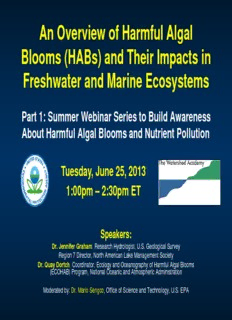
An Overview of Harmful Algal Blooms (HABs) and Their Impacts in Freshwater and Marine ... PDF
Preview An Overview of Harmful Algal Blooms (HABs) and Their Impacts in Freshwater and Marine ...
An Overview of Harmful Algal Blooms (HABs) and Their Impacts in Freshwater and Marine Ecosystems Part 1: Summer Webinar Series to Build Awareness About Harmful Algal Blooms and Nutrient Pollution Tuesday, June 25, 2013 1:00pm – 2:30pm ET Speakers: Dr. Jennifer Graham, Research Hydrologist, U.S. Geological Survey Region 7 Director, North American Lake Management Society Dr. Quay Dortch, Coordinator, Ecology and Oceanography of Harmful Algal Blooms (ECOHAB) Program, National Oceanic and Atmospheric Administration Moderated by: Dr. Mario Sengco, Office of Science and Technology, U.S. EPA Today’s Schedule • Introduction and GoToWebinar Logistics • Dr. Jennifer Graham – NALMS – Algae, Blooms, and Cyanobacteria • Dr. Quay Dortch – Coastal HABs – NOAA • Polling Questions • Q&As • Final Announcements #greenwater 2 Webinar Logistics • To ask a question – Type your question in the “Questions” tool box on the right side of your screen and click “Send.” Our panelists and moderator will respond to the entire audience. • To report any technical issues (such as audio problems) – Type your issue in the “Questions” tool box on the right side of your screen and click “Send” and we will respond by posting an answer in the “Questions” box. • To find additional support online – Refer to GoToWebinar’s website: http://support.citrixonline.com/GoToWebinar/ or call 1-800-263-6317 for toll-free support. 3 Today’s Topic and Speakers Freshwater HABs Jennifer Graham, PhD • Research Hydrologist, USGS • Region 7 Director, NALMS Coastal HABs Quay Dortch, PhD • Center for Sponsored Coastal Ocean Research, NOAA • ECOHAB and PCMHAB Programs, NOAA 4 North American Lake Management Society (NALMS) • NALMS mission is to forge • Membership benefits include: partnerships among citizens, – Monthly newsletters scientists, and professionals to – LakeLine magazine foster the management and – Lake and Reservoir protection of lakes and reservoirs Management scientific journal for today and tomorrow. – Annual symposium – Networking with lake-minded • NALMS membership is diverse individuals and includes citizens, scientists, – Opportunities to be involved at lake professionals, and policy local, regional, national, and makers. international levels www.nalms.org 5 July is Lakes Appreciation Month Enjoy and bring attention to local freshwater resources • State Proclamations in recognition of the importance of lakes – 2013 Proclamations: CO, IL, MO, NH, NV, OH, VT • Get involved: – Volunteer monitoring activities – Annual Secchi Dip-In – Lake/Watershed Clean-Up Events www.nalms.org 6 NALMS INLAND HAB PROGRAM Information Resource for HABs • Web Resources: http://www.nalms.org/home/ programs/blue-green-algae- initiative/blue-green-algae • Dedicated issues of LakeLine and Lake and Reservoir Management • Special sessions at annual symposia www.nalms.org 7 Freshwater Harmful Algal Blooms Jennifer L. Graham U.S. Geological Survey Lawrence, Kansas 8 What Are Algae? • Algae are simple photosynthetic plants. • Like all plants, algae have chlorophyll, which is a pigment used to capture light Pediastrum for photosynthesis. • Algae are an important part of the food web in aquatic ecosystems and are eaten by many simple animals and some fish. Cymbella photos courtesy of PhycoTech, Inc. 9 What Are Cyanobacteria? • Cyanobacteria are true bacteria, but have chlorophyll-a like algae. • Structurally the cyanobacteria are bacteria-like, but functionally they are algae-like. Gloeotrichia echinulata • Because cyanobacteria function like algae in aquatic ecosystems, they typically are considered to be part of algal communities (this is why they often are called blue-green algae). Microcystis aeruginosa Images from Rosen and others, OFR 2010-1289 10 http://pubs.usgs.gov/of/2010/1289/
Description: